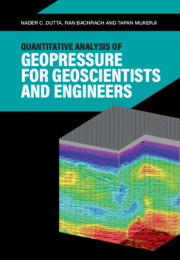Book contents
- Quantitative Analysis of Geopressure for Geoscientists and Engineers
- Quantitative Analysis of Geopressure for Geoscientists and Engineers
- Copyright page
- Contents
- Preface
- 1 Basic Pressure Concepts and Definitions
- 2 Basic Continuum Mechanics and Its Relevance to Geopressure
- 3 Mechanisms of Geopressure
- 4 Quantitative Geopressure Analysis Methods
- 5 Seismic Methods to Predict and Detect Geopressure
- 6 Integrating Seismic Imaging, Rock Physics, and Geopressure
- 7 Methods for Pore Pressure Detection
- 8 Gravity and EM Field Methods Aiding Pore Pressure Prediction
- 9 Geopressure Detection and Prediction in Real Time
- 10 Geopressure Prediction Using Basin History Modeling
- 11 Geohazard Prediction and Detection
- 12 Petroleum Geomechanics and the Role of Geopressure
- 13 Guidelines for Best Practices
- 14 Recent Advances in Geopressure Prediction and Detection Technology and the Road Ahead
- Book part
- References
- Index
8 - Gravity and EM Field Methods Aiding Pore Pressure Prediction
Published online by Cambridge University Press: 10 February 2021
- Quantitative Analysis of Geopressure for Geoscientists and Engineers
- Quantitative Analysis of Geopressure for Geoscientists and Engineers
- Copyright page
- Contents
- Preface
- 1 Basic Pressure Concepts and Definitions
- 2 Basic Continuum Mechanics and Its Relevance to Geopressure
- 3 Mechanisms of Geopressure
- 4 Quantitative Geopressure Analysis Methods
- 5 Seismic Methods to Predict and Detect Geopressure
- 6 Integrating Seismic Imaging, Rock Physics, and Geopressure
- 7 Methods for Pore Pressure Detection
- 8 Gravity and EM Field Methods Aiding Pore Pressure Prediction
- 9 Geopressure Detection and Prediction in Real Time
- 10 Geopressure Prediction Using Basin History Modeling
- 11 Geohazard Prediction and Detection
- 12 Petroleum Geomechanics and the Role of Geopressure
- 13 Guidelines for Best Practices
- 14 Recent Advances in Geopressure Prediction and Detection Technology and the Road Ahead
- Book part
- References
- Index
Summary
This chapter highlights nonseismic potential field methods so that exploration geoscientists can include these for quantitative evaluation of geopressure. That nonseismic methods such as gravity and E&M methods are useful for exploration is beyond question. These methods are also applicable to geopressure investigation.Given an understanding of how the tools behind the potential field technologies work in their current forms, we believe that these methods will add to seismic technology for geopressure analysis. Despite being comparatively low resolution, they have some advantages. For example, at a comparatively low cost, airborne potential field surveys can provide coverage of large areas.
Keywords
- Type
- Chapter
- Information
- Publisher: Cambridge University PressPrint publication year: 2021

